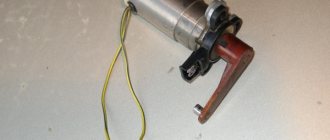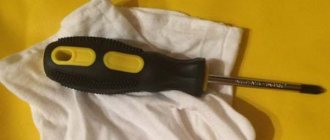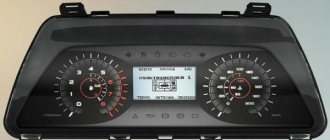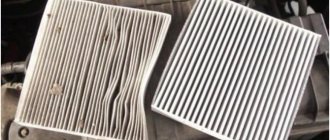On the VAZ 10th family, which includes the VAZ 2110-2112 models, the designers used an electronically controlled interior heating system, thanks to which the temperature set by the driver is maintained automatically.
On the VAZ-2110, instead of a manual heater control mechanism with a cable drive of the main elements - the coolant shut-off valve and dampers, an automatic heater control system (AHC) controller with a temperature sensor and a gearmotor that regulates the position of the dampers are used.
In such a stove, the valve for shutting off the antifreeze supply is no longer used, and the adjustment of the heater operating mode - “heating” or “ventilation” - is carried out by a central damper, which directs the air flow through the radiator or bypassing it.
How malfunctions manifest themselves
The automatic temperature maintenance system used on the VAZ-2110 is more convenient in terms of control, since the automatic control system does everything independently, but is less reliable than a mechanical cable drive. Moreover, problems are caused by the electronic and electrical components of the stove - the controller, temperature sensor and micromotor gearbox, the central damper, which regulates the air supply to the cabin from the outside.
Problems with the operation of the VAZ-2110 heater related to the damper:
- lack of temperature control (only hot or cold air comes from the stove) regardless of the position of the handle on the controller;
- insufficient air heating (even when setting the handle to the maximum temperature);
- squeaks, knocks and extraneous noises after setting the temperature.
The cause of such problems is the central damper of the VAZ-2110 stove, which is adjusted by the controller through a gearbox. The design of the stove includes another damper - air distribution into zones. It is controlled using a handle mounted on the central air supply deflector into the cabin, so malfunctions with this part are rare.
Stove design
This unit includes several devices. The radiator is the main element of the stove - it heats the air entering the cabin. It is located under the hood. The next component is the air distributor, equipped with special pipes that run through the cabin of the 2110.
If we compare the “ten” with previous models, an important innovation has appeared in its heating system - an evaporator (the diagram includes it in the list). The device is installed in an air conditioning system. Not all owners know about its existence, since it rarely fails.
To control the operation of the heater, an SUAO unit is installed in the VAZ 2110 car, which is called a controller in the technical operating manual. The unit works in conjunction with a temperature sensor in the cabin; it is also called a ceiling sensor. The sensor reports the temperature to the unit, then this indicator is compared with the set temperature on the handle. If the indicators differ by more than 2°, warm or cooled air is supplied to the VAZ 2110 interior.
It’s worth taking a closer look at the handle, or more precisely at its extreme positions – MAX and MIN. If the heater knob is set to one of these indicators, heat is supplied without the operation of the temperature sensor in the cabin. The scheme includes all of the above elements.
The device of the “tens” heater includes another unit - a gearmotor, which is responsible for opening and closing the damper. The miniature electric motor performs an important task in the operation of the heating system, as evidenced by the diagram. If the gearmotor is faulty, the system will only produce cold or hot air. If the gearmotor fails when the damper is closed, the system will stop functioning. We have described the main components of the VAZ 2110 heater; the diagram contains a more detailed list.
Let us highlight the main components of the system:
- Radiator.
- Air distributor.
- SUAO block.
- Ceiling sensor.
- Lever.
- Damper.
- Gearmotor.
Radiator
In the heating system, a radiator is installed for heating, which enters the VAZ 2110. It is also called a heat exchanger. Heating is carried out by the heat of the antifreeze. This component is connected to the engine cooling system by pipes and hoses. Antifreeze constantly circulates through the heat exchanger of the stove. The damper, based on the commands of the unit, directs the incoming air to the radiator or directly into the passenger compartment. If the heater damper is in an intermediate position, then one part passes through the heat exchanger, and the second bypasses the radiator. If we compare this part of the stove with previous generations of the VAZ, it has a number of useful improvements, as the diagram demonstrates.
SUAO and ceiling sensor
These components of the VAZ 2110 heater are connected and operate according to the following principle:
- The sensor determines the temperature inside the car;
- This data is sent to the SUAO block;
- The block compares the temperature with the position set on the handle of the VAZ 2110 stove;
- After comparison, the position of the damper changes or remains the same - it depends on the indicator;
- This way the temperature in the cabin is controlled;
- If the heater handle is set to MAX or MIN, then the data from the ceiling sensor is not taken into account.
All these actions are demonstrated by the diagram. The block is a set of microcircuits; the normal operation of the stove depends on its serviceability. Both the sensor and the control system can be replaced.
see also
Damper and gearmotor
The heater gear motor changes the position of the damper, due to which air is supplied to the cabin. This component is controlled by the control system block. If the device is faulty, the damper will not move. The unit is a miniature electric motor. When it breaks, it is usually replaced, since repairing it will be problematic. This also applies to the damper. The diagram shows the connections between the gearbox and the block.
Features of the design of the VAZ - 2110 stove damper
Note that VAZ-2110 of different years of manufacture uses heaters that differ in design:
1. Old-style stove damper
Old heaters use two central dampers, one of which blocks the flow of air into the cabin from the outside, and the second one redirects the air flow to the heater radiator or bypasses it. They are interconnected by drives and opened by a micromotor gearbox.
2. New sample
In the new type of stove there is only one central damper and it is connected by a drive to the gear motor directly, and not through a lever.
3. Under the “Euro” panel
Structurally, such a stove does not differ from the new type of heater, but in it the damper for distributing the air flow into zones is controlled by another micromotor gearbox.
It is easy to visually distinguish the stoves by the location of the heater fan. In the old-style interior heater, the fan is located horizontally, while in the new model, it is positioned vertically. Their gearmotors are also different.
Weak warm air supply
The air flow is warm enough, but the pressure is insufficient. In such a situation, the following malfunctions are possible:
- The cabin filter is dirty. In this case, you need to clean it from dust with a vacuum cleaner. If this cannot be done, then it is better to replace it.
- The stove radiator is clogged. In addition to dust, both insects and leaves create plugs. Small particles can be blown out using compressed air. To remove large dirt, you need to remove the grill and wash it.
Insufficient air pressure may be due to a leaking radiator. This problem is determined very simply - if you constantly add antifreeze or antifreeze, then pay attention to the condition of this unit in the car. To eliminate this malfunction, you will need to gain access to the radiator and remove it along with the heater.
The practice of soldering the heatsink is unreliable. It is better to install a new part so as not to disassemble half of the front end later.
Causes of malfunctions
Depending on the design of the stove, the damper may cause a disruption in the efficient operation of the heater for the following reasons:
- deformation;
- wear of seals;
- deterioration or damage to control levers and rods;
- skew.
Deformation is a problem with old-style heaters. The first dampers of the VAZ-2110 stove were equipped with plastic elements that bent under the influence of temperature. Because of this, even when completely closed, cold air from outside leaks in and mixes with the heated air, and the efficiency of the stove decreases. Subsequently, the designers replaced the plastic flaps with aluminum ones and the problem with deformation disappeared.
To ensure tightness, the dampers have seals that reduce air leakage. Initially, foam rubber seals were used, which quickly wore out and became damaged. Later, foam rubber was replaced with rubber, but this only extended the service life of the seal; over time, the rubber ages, cracks and collapses.
On old-style stoves, rods and levers may break. On new heaters, there is another problem - wear on the edges of the square end of the gearbox, with which it is inserted into the groove made in the damper axis. As a result, the limit switch bypasses the groove, and the heater damper jams, although the gearmotor operates. The misalignment occurs due to the displacement of the damper axis in the mounting holes of the housing. Because of this, the damper warps and jams when opening.
The main reasons for poor operation of an electric furnace
VAZ 2110 stove diagram
Before you can directly begin to find a solution to a problem, you need to be able to identify it quickly and effectively. First, it is advisable to consider the general structure of the furnace. So, the heater furnace consists of the following components:
- mounting block fuse;
- incendiary lock;
- ignition switch together with its unloading relay;
- a special switch that regulates the operating mode of the furnace electric motor;
- additionally built-in resistor;
- stove motor;
- heated rear window of the car, which contains a heater adjustment button with a light indicator;
- a special functional element for heating glass.
VAZ 2110 stove wiring diagram
One of the reasons for the malfunction of the electronic circuit of the furnace may be the lack of functional activity of the heater electric motor at both low and high speeds. In this situation, you must proceed as follows:
- First you should make sure that the fuse has not accidentally blown;
- If a blown fuse is detected, it will urgently need to be replaced with a new one.
Diagnosis of the problem
If the reason why the VAZ-2110 stove does not work is the damper, it is not difficult to identify it. To do this, disassemble the central deflector, turn on the ignition and rotate the temperature setting knob to its extreme positions. In a working stove, the central damper will not knock and will completely open and close the air supply channel.
If the heater damper does not move or stops in a position that does not completely block the air passage, it may be stuck. You can verify this by pushing the valve with your hand or a long rod. If after this the damper returns to its normal position, then this is the reason why it is jammed. Through the mounting hole of the deflector, you can assess the condition of the damper and its seals. If the damper is deformed, its bend is clearly visible.
How the oven works
VAZ 2110 models of the first years of production are equipped with an old-fashioned stove.
You should know that the design of the old-fashioned VAZ 2110 stove does not differ significantly from the new version, regardless of the power unit used, with the exception of a few points that will be discussed below:
- even micro gearboxes are different. Older elements have slightly different resistors. Therefore, before starting repair work, make sure that the appliances are truly interchangeable, and that you purchased old heating elements for the old version of the oven, and not new ones. Otherwise, difficulties will arise with the functioning of this element.
- radiator design. The main difference between ovens is this. So, if you intend to install a new radiator instead of an outdated version, then you need to take into account some installation nuances;
- The controller handle on the devices is slightly different. Old technology has a serious drawback: it is no longer produced. For this reason, position controls 4 and 5 manufactured before 2004 are not suitable for a new oven;
How to fix a stove
As already mentioned, the heating systems on VAZ 2110 models are practically no different from each other in design. And it doesn’t matter which engine is under the hood: carburetor or injection.
So the repair manual described below can be used by all owners of “dozens” of VAZs.”
If you are planning a major overhaul of a stove manufactured before 2003, we recommend purchasing a radiator first. A copper element is more suitable as it is more efficient and allows the stove to perform better.
Principles of interior ventilation
Before you understand the causes of the malfunction, you should know the principle of the device and the rules by which ventilation is carried out. So:
- Air is supplied to the passenger compartment through the holes in the trim on the windshield : when the car is moving voluntarily, or forcibly with the help of a heater fan.
- Air escapes through the gaps between the inner door panels and between the upholstery, then through the holes located at the ends of the doors. The thermal insulation of the interior is improved by valves built into the openings, which allow air to pass out and prevent it from entering the inside of the car.
- The main part of the air is directed to the windshield; flows are directed to the central part and side windows through deflectors blocked by flaps.
- Air is supplied to the driver’s feet and the passenger sitting next to him through two pairs of deflectors: one pair is located near the floor, the other at knee level.
- Through a lining located on the floor tunnel and two air ducts built under the front seats, air is supplied to the feet of passengers in the rear.
- To prevent the entry of outside air, especially if the road section is polluted, smoky or very dusty, there is an air recirculation system. When the recirculation button is recessed on the instrument panel, the electro-pneumatic valve opens. In this case, under the influence of the vacuum that occurs in the intake pipe, the access of outside air is blocked by the recirculation system flap into the vehicle interior.
- The air temperature is regulated by the controller handle from 16°C to 30°C.
- Information about the temperature is read from its sensor by a unit with a microfan located on the ceiling. The unit turns on the micromotor when a temperature difference occurs, which controls the heater dampers. When the damper reaches the desired position, a signal is sent from the sensor to the control unit, which turns off the micromotor.
Components and processes of the VAZ-2112 heater
- resistor;
- electro-pneumatic valve;
- damper on the stove channel;
- recirculation flap control valve;
- radiator and its casing;
- stove control damper;
- water-reflecting air intake deflector;
- fittings for steam outlet and supply pipelines;
- cover from the stove lining.
- casing from the air intake of the heating system, consisting of front and rear parts;
- micromotor-gearbox with damper control;
- stove motor in the housing and fan;
- support platform for the heater control hatch activation lever and the lever itself;
- recirculation deflector on the air intake;
The radiator is located horizontally under the instrument panel. It is enclosed in a plastic case. The radiator design includes two plastic tanks and a pair of aluminum tubes on which plates are molded. There is a steam outlet on the left side of the tank. The passage of intake air through the radiator depends on the position of the dampers. If the shock absorbers are in the extreme position, all the air flow may pass through the radiator or not at all.
Lack of tap - plus or minus?
While older VAZ models have a tap that can be used to shut off the supply of antifreeze to the radiator, the VAZ-2112 is not equipped with such an element. If the engine is running, the radiator heats up regardless of the time of year. This design feature of the stove makes it possible to achieve a small inertia, which is inherent in the system when starting up. In other words, the required temperature will be reached in a shorter time. Additionally, the user will not have to deal with leaks that occur as a result of a leaking faucet. The electronic control unit, which generates the necessary commands, is responsible for the ability to conveniently control the operation of the stove.
Malfunctions in the heating system of the VAZ 2110 and methods for eliminating them
If a control unit, a temperature sensor with a microfan, a micromotor, or a heater damper position sensor fails, it is best to replace it with new ones, otherwise the cost of repairing the vehicle may become significantly higher if it continues to be used with faulty components. If the moving damper makes a characteristic sound that can be heard in the cabin, and the air does not warm up, then the damper or its drive is damaged . In this case, it is necessary to replace the heater damper of the VAZ 2110 or replace the heater damper drive of the VAZ 2110.
Replacing the heater gear motor
To perform this procedure, you will need wrenches and a shaped screwdriver. Installing a new part is not very difficult, so a novice car enthusiast can easily handle it in a personal garage.
Replacement procedure:
- remove the windshield wipers, unscrew the locknut and release the frill;
- Now we have free access to self-tapping screws;
- At this stage, you need to remove the rubber seal from the electric motor compartment. To do this, you need to unscrew the nuts on both sides of the frill;
- the damper pipeline must be disconnected so that it does not interfere;
- Unscrew the screws holding the gearbox thermal radiators;
- near the vacuum brake booster in the left niche of the gearbox compartment there is a motor that must be removed by unscrewing the screw securing it from below;
- The damper is assembled in the reverse order immediately after installing the heater gearmotor.
Testing the functionality of the installed element is carried out by measuring the resistance on contacts X1.1 and X1.4 with the controller turned off and the left regulator set to the blue mark position. If there is no resistance or remains constant during the test, this indicates a faulty shaft position sensor. Unfortunately, it is not sold separately, so you will have to change the gear motor.
Replacing the damper in the heating system of a VAZ 2110
Replacing the damper in the VAZ 2110 heater is carried out in the following cases:
- Exit from the working state.
- Constant jamming. This happens when the valve is skewed or damaged by corrosion. In this case, the heater does not need to be disassembled. Simply remove the centrally mounted deflector and manually activate the damper.
On a VAZ 2110 car, dampers can be installed of an old or new type. The old one is made of plastic with foam insulation, the new one is metal with a rubber seal.
Advice: If it is necessary to replace the heater damper of a VAZ 2112, it is better to use metal devices of a new type.
Removing the heater damper VAZ 2110
- Drain the liquid from the cooling system.
- The “-” wire is disconnected from the battery terminal.
- The trim, the frame trim on the windshield and the sound insulation upholstery are removed.
- The heater fan is removed.
- The vacuum hose clamp is disconnected from the heater body.
- Remove the three spring clips that secure the front heater air intake housing.
Tip: to make it easier to unscrew and tighten the screws securing the air collector, you can remove the instrument panel, unscrew the screws securing the heater and lift it.
- Remove the screws securing the front housing.
- The front housing is removed.
- The radiator is freed from all hoses.
- The rear heater casing is removed.
- The radiator is removed from the heater.
- A new damper is installed so that the fork located on the damper axis is engaged with the lever.
- The damper must be in the raised position.
- The heater is reassembled in the reverse order of disassembly.
- Coolant is being added.
- The tightness of all connections and hoses, the operation of the dampers, and the entire heater are checked.
How the heater damper is replaced on a VAZ 2110 can be clearly seen in the video; the heater damper is replaced in a similar way on a VAZ 2112 model car.
Assembly
Damper location
After this, reverse the assembly procedure according to the dismantling steps. Refill the system with coolant and check that the new damper is in place. It is important to ensure that there are no leaks and that the hose connections are not tight.
Turn on the stove and check how the heater behaves. If everything is normal, you have carried out competent and successful work, for which we congratulate you.
Adjusting the heater dampers
By adjusting the dampers with your own hands, you eliminate the supply of part of the air “to the glass” when the lever that controls the air flow is installed in the heater in the “chest” or “legs” position. The photo shows the damper adjustment control units.
Adjustment unit with control lever positioned vertically
2 – adjustable rod for installing the damper “in the chest” – “in the legs” 3 – fastening the rod “in the chest” – “on the glass”. To do this, you need to shorten the adjustable rod by three divisions, and use side cutters to bite off the protruding tip on it. After performing such operations, the heater damper will be in the desired position, and the heat from the stove will flow better in the given direction.
The stove blows cold air
If the antifreeze is at operating temperature, the tap is open and the system as a whole is operational, then the reason for the supply of cold air can only be the formation of an air lock in the radiator. This problem is solved as follows:
- The car is placed on any hill so that the front part is higher than the rear axle.
- Open the tap on the radiator.
- Start the engine and let it run for 5 minutes. During this time, periodically press the gas pedal.
- Now we slide down the hill, close the tap and check the heating system.
Useful information on using the heater
The above methods help improve interior heating. But it wouldn’t hurt for motorists to familiarize themselves with the operating rules of the stove and adjacent systems. This will help keep the heater in working condition:
- If you have installed an air conditioner in a VAZ 2110, then it is best to run it in wet weather.
- In cold weather, it is most effective to use two positions of the heater: “all on your feet” - when starting to drive, “all on the glass” - a minute before the car starts.
- The nozzles should not be blocked by anything. Motorists often place carpets on them, which absorb heat. To avoid this, you need to raise the nozzles above some kind of lining. Then nothing will disturb them when the blower is running.
- Before starting the stove in the cold season, it is necessary to clean all the glass from moisture or dirt.
Advice from experienced car owners
Eugene:
“I never thought I would encounter such a problem, but it happened. After repairing the cylinder head, it became very difficult to warm up the interior. I spent a long time searching for why, and it turned out that the engine was throttling. I did everything as advised, the coolant stopped bubbling only after 4 hours, but now it’s always warm in the cabin.”
Sanya:
“I have a VAZ 2109i, it blew cold at idle. I added coolant to the expansion tank, everything was ok.”
Rustam:
“I drive a 6th Mazda. Last winter, the heater began to act like a fool: over 2 tons of revolutions, hot air came out of it, over 3 tons, despite how much the temperature was set, the heater practically boiled with boiling water, but as soon as you stopped, the air became cool. I went through all the possible options described in the article, the problem did not go away, after a long search, the service station technicians found the reason - the climate control system had failed.”
We recommend: What to do if the wipers on a VAZ-2110 do not work: possible reasons
Ruslan:
“On my Priora, the stove also blew cold at idle, so to fix this I had to constantly add antifreeze. Got tired of it, sealed the lower pipe, now everything works properly.”
Oleg:
“As a service station worker, I can say that the warmest stove among all domestic cars is in Kalina, but sometimes it also malfunctions
As a rule, the whole problem lies either in the gasket of the pump, or in the pump itself, so if you are the owner of the named car, in which case the first thing you should pay attention to is the pump and its components.”











